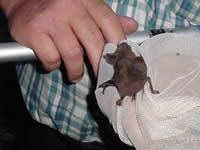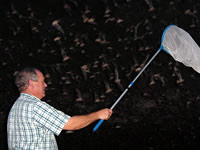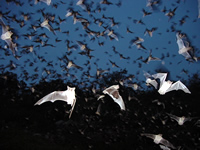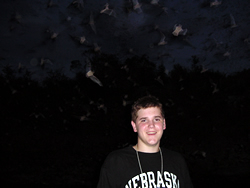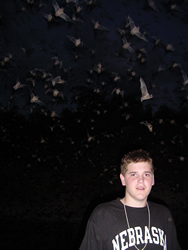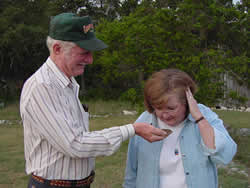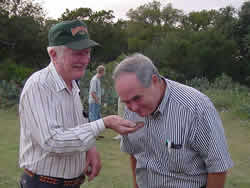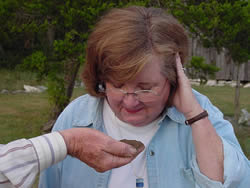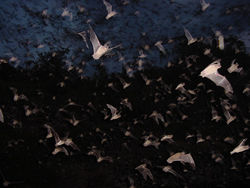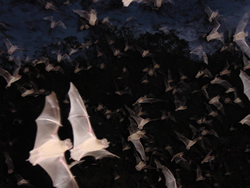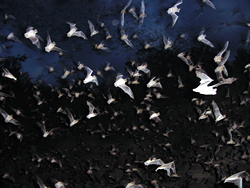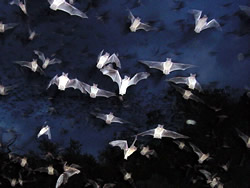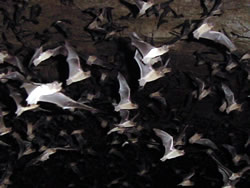|
QUESTION: Are bats dangerous? Do they carry
rabies? What do they
eat? Does bat guano (feces, poop, excrement, crap, etc.) stink?
ANSWER: Bats are the only mammals that actually
fly (flying squirrels
glide). They also have a highly developed echolocation system
which
allows them to capture flying insects at night. Bats catch insects
in flight either with their mouth, wings, or tail membranes. They
usually forage from about an hour after sunset to about an hour
before sunrise, stopping to rest occasionally under open porches,
eaves, trees or other overhanging structures.
Bats spend their days roosting in a semi?torpid state. Often
bats
choose to roost in the attic or walls of occupied dwellings, posing
problems for property owners. Most colonies of bats go unnoticed,
but they may become a nuisance due to their vocalization and
activity, or odors and stains from urine, feces and rejected food.
Many residents wish to eliminate these winged mammals because
they can infect humans or pets with rabies. Only a small proportion
(less than 1 percent) of bats are rabid. Even if rabies is
confirmed from one bat in a colony, most of the remaining animals
will be healthy. Symptoms of rabid bats include erratic flight,
activity during the daytime, and weakness or paralysis causing
the
bat to fall from its roost. Most human exposure to rabies occurs
when people attempt to help grounded bats. If sick or dead bats
are
found, local public health agencies should be contacted immediately.
DON’T TOUCH DEAD OR SICKLY BATS!!!!!!! And don’t let
them bite you!!!!!!!!
The big brown bat (Eptesicus fuscus), Eastern pipistrelle
(Pipistrellus subflavus), and four species of little brown bats
(Myotis spp.) are social bats. They usually form roost colonies
during summer in attics, barns, caves or the walls of older
buildings. A colony may consist of a few dozen up to several hundred
individuals. The bat cave at Bracken (near San Antonio, Texas)
has the largest population of bats in the world ----millions!!!
Most species of bats mate promiscuously during the fall.
The young of social species are born in maternity colonies
during late spring. Adult females have only one litter per year,
and
bear one to two young per litter. Body heat from the colony
maintains warm temperatures for the young bats. Juveniles develop
rapidly, and are usually able to fly in about three weeks. Bats
have
a relatively long life span, and may survive 10?20 years.
No pesticides are currently registered for lethal control of
bats in
the United States. Chemical controls may actually increase bat
rabies risks by producing sick individuals, or by driving bats
from
attics into living areas.
What can homeowners do if bats decide to roost in their attics?
The
only long?term control method is to bat-proof the home or building
in
which a colony is roosting. All bats should be outside the building
before the entrance points are sealed (implement control efforts
at
night). Bat-proofing should be attempted as soon as an unwanted
colony is detected, except during early summer when young flightless
individuals may be present. Trapped bats will soon die creating
foul
odors.
Main access points to structures are found by observing the
animals
leaving the building at dusk. Bats may enter an opening as small
as
1/4 x 1?1/2 inches. Cracks or crevices can be sealed with caulking
compound or oakum. Larger openings can be covered with metal
flashing or 1/4?inch mesh hardware wire. One primary hole should
be
kept open until bats exit for the evening, then it can be
temporarily closed with a wad of aluminum foil. Trapped animals
will
leave the following evening if the seal is removed at the normal
exit time. After checking for remaining individuals, the opening
can
be permanently sealed. Bats will seek other entry points, so the
building should be checked each evening for several days.
Colonies in horizontal moldings or behind shutters will be
discouraged by removing the shutters or opening the molding so
there
are no dark recesses. Shutters can be reattached to the home with
1?2 inch wooden block spacers.
Installation of lighting in roost areas will also discourage
bats
(install wires properly to avoid fire hazards). The lights should
be
left on 24 hours a day for several weeks. Increasing ventilation
to
lower temperatures may cause bats to leave in some cases.
Mothballs (naphthalene or paradichlorobenzene) may repel colonies
in confined areas with poor ventilation. Recommended application
rates are usually high, and vapors could reach living areas posing
a
health hazard to humans. Ultrasonic devices have not effectively
repelled bats.
To remove a single bat from an occupied room, turn the lights
on and
open the window. Usually the bat will leave on its own without
handling. If this doesn't work, wait for the bat to land and cover
it with a coffee can. Slide cardboard under the can, and release
the
bat outdoors if it has not contacted humans or pets.
Once bats are removed from a dwelling, any caked fecal material
or
crystallized urine should be removed from flooring or beams. The
odor of bat excrement may act as a pheromone and attract other
bats.
The fungus Histoplasma capsulatum can be contracted by breathing
spores in the dust of bat feces, so respirators and protective
clothing should be worn while working in bat roosts. All
contaminated insulation should also be discarded. Surfaces
contaminated with urine or feces can be disinfected by spraying
with
a solution of 1 part bleach/20 parts tap water. Deodorants can
then
be applied to mask any remaining odors.
In summary, bats are beneficial because they eat large numbers
of
insects. Excluding bats from structures will be the most practical
type of bat control.
Adapted from Paul D. Curtis, Department of Natural Resources,
Cornell University, 2001
|






